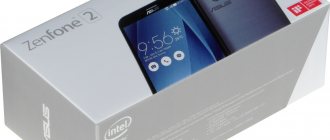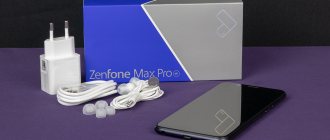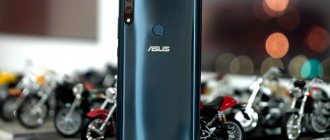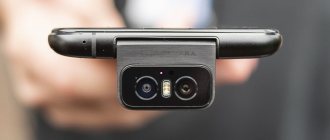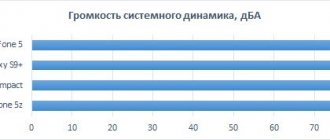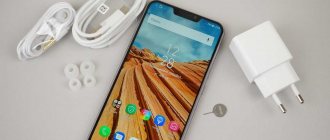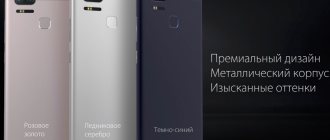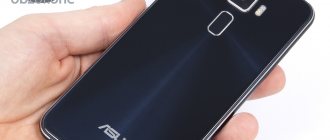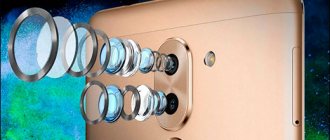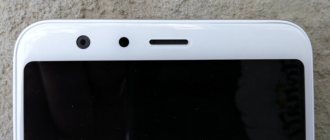Test results
ASUS has already released so many cool smartphones and camera phones under the ZenFone brand that the word “Zenfone” risks becoming a household name like “iPhone.” In any case, the manufacturer’s devices successfully stand out from competitors with their premium performance and quite affordable price. The ASUS ZenFone 4 Max (ZC554KL) also succeeded, although not in everything. True, at a price of 11,000/15,000 rubles for the version of the device with 16/32 GB of memory, this is a very good smartphone in the middle class. Moreover, the younger version has come very close to the budget segment of devices, retaining the high-quality style of the manufacturer in everything.
| pros | Minuses |
| + All metal body | - Not enough internal memory |
| + High quality workmanship | |
| + Battery capacity 5000 mAh | |
| + Dual camera |
ASUS ZenFone 4 Max: body and display
The 5.5-inch smartphone is made in a pleasant-to-touch metal body with rounded edges and creates a feeling of solidity of design. Analog controls sit firmly in the niches provided for them, do not play and respond accurately when pressed.
The IPS matrix of the camera phone (size 68x121 mm) displays contrasting and natural colors and ensures good readability in direct sunlight. But the resolution here is only HD (720x1280 pixels) with a pixel density of 269 dpi. However, this is not a minus, because the visual difference with FHD resolution is not noticeable at all.
All interface elements look smooth, and you won’t be able to see individual pixels on the screen, no matter how closely you look. Moreover, the lower the display resolution, the less battery power the video core consumes when rendering interfaces. So this move by the manufacturer is completely justified. As for touch input, the screen supports up to ten touches simultaneously and clearly responds to touch commands.
Another clever approach was found here: a fingerprint sensor for reading fingerprints is placed on the front panel of ASUS ZenFone 4 Max (ZC554KL) and integrated into the Home button. This is convenient: you don’t have to try to find the scanner on the back panel and try to reach it with your finger.
In this embodiment, the fingerprint sensor is located directly in front of the eyes and at the usual distance for the thumb. Together with a password or pattern key, this combination of technologies ensures maximum security of your data in case your smartphone is lost or, even worse, stolen.
Review of the ASUS ZenFone 4 Max ZC554KL smartphone: Maximum energy and dual camera
Probably, everyone has had a situation when in the evening you run home with all your might to the socket to charge your smartphone, and all because you are waiting for an important call or message and you don’t want to be left without communication. There are, of course, rescuers from such a situation - power banks, but I really want to just not worry about the remaining charge on my smartphone. Understanding this state of affairs, ASUS presented a smartphone with a capacious battery ASUS ZenFone 4 Max ZC554KL, but its feature is not only freedom from an outlet, but also a dual camera, and the price tag is not “biting” - 13,990 rubles. Read about all the features, pros and cons of the new product in this review.
Characteristics
| Housing material | metal, plastic, glass |
| Screen | IPS 5.5” 1280x720 |
| Memory | Main 16/32 GB (expandable up to 256 GB) RAM 2/3 GB |
| OS | Android 7.1.1 |
| SOC | Qualcomm Snapdragon 425, |
| Camera | Main 12 MP (80º)+5 MP (120°) Front 8 MP |
| Battery | Non-removable 5000 mAh |
| USB | Micro-USB |
Packaging and equipment
The smartphone is packaged in a simple cardboard box with fairly high-quality printing; on the front side of the box you can get acquainted with the appearance of the device; on the left side there is the inscription “WE LOVE PHOTO”, which immediately makes it clear that something interesting awaits us in terms of cameras. All main characteristics are indicated on the service sticker on the back of the box.
In the kit you will find: micro-USB cable, charger, OTG cable, pin for opening the tray, user manual, warranty card.
Appearance, arrangement of elements and ergonomics
Let's start with the fact that there are two versions of ASUS ZenFone 4 Max: ZC520KL and ZC554KL, differing mainly in screen diagonals of 5.2″ and 5.5″ and battery capacities of 4100 MAh and 5000 MAh, respectively. Besides the difference in models, there are various different color options available: black, gold and pink; By the way, black is not quite black, but rather dark blue. We tested the older model in black.
The front of the smartphone is completely covered with protective glass with nice rounded edges. Above the display there is a speaker, front camera, flash and proximity and light sensors; under the display there are touch keys and a rectangular fingerprint scanner, which is slightly recessed relative to the main glass and is easy to feel even in the dark. The side frames near the screen are large, but this is easily justified by the very capacious battery.
You take the smartphone in your hand and feel a pleasant chill from the metal - yes, the back of the ASUS ZenFone 4 Max is made of metal, which, when sandblasted, received a pleasant matte surface, thanks to which the smartphone “clings” to the hand, but this solution also has a drawback - it easily collects dirt. It is not completely metal and there are well-disguised plastic inserts on the bottom and top, which at first glance are quite difficult to distinguish from metal.
On the back of the ASUS ZenFone 4 Max is one of its advantages - a dual camera and a single-color LED flash, which we will talk about a little further. In addition, slightly below the cameras in the center, the ASUS logo is modestly and almost imperceptibly located.
The edges of the smartphone are rounded and do not hurt your hand at all. The right side is occupied only by the tray, which is so lacking in many smartphones; you can install two nano-Sims and a MicroSD memory card in it, and all this at the same time (ASUS, thank you! Keep it up!).
The right side has a lock key and a volume rocker. In order to highlight the keys as much as possible, small, barely noticeable notches are made on them, which are tactilely felt. The keys wobble quite a bit if you move your finger over them, but in normal mode they do not wobble, have medium hardness and a fairly loud click.
On the top edge there is a noise reduction microphone and the very same connector that many flagships lack - a 3.5 mm Mini - Jack for headphones. And let them persistently tell us. that it’s time to switch to wireless sound; the old analog connector is still very popular.
But on the lower edge we are faced with micro disappointment - MicroUSB, but it would be possible to install a modern, fashionable, youth USB Type C, but we will have to be content with what we have. To the right and left of the MicroUSB there are two perforations, under which the microphone and speaker are hidden, respectively.
It’s difficult to talk about the ergonomics of the ASUS ZenFone 4 Max ZC554KL; on the one hand, this is one of the smallest and lightest smartphones with a capacious battery, dimensions 154x76.9x8.9 mm and weight only 181 grams. But despite all this, the dimensions are still large and, for example, for a small female hand, I would recommend taking a closer look at the younger model ZC520KL. The main thing is that all the elements are in convenient places and, in general, the smartphone fits well in the hand.
Display
ASUS ZenFone 4 Max ZC554KL is equipped with a large 5.5″ IPS matrix with a resolution of 1280×720 and this is perhaps the only drawback of this matrix, yet the pixel density is not the same as at 1080p at the same resolution. If you look closely, you can see graininess. But to be honest, no one peers at the display in everyday use to look at the pixels, and at the same time, using a lower resolution, on the contrary, gives an increase in performance and autonomy. The color rendition of the display is natural and quite calm without obviously too high contrast; in terms of color temperature, the display gives off a bit of cool tones.
The viewing angles of the display are also okay, what can I say, a good IPS matrix makes itself felt. Whether tilted vertically or tilted horizontally, the image remains perfectly readable. The brightness is adjustable over a wide range and you can select the optimal mode both for complete darkness and when using a smartphone in bright sunlight; adaptive brightness control, by the way, behaves adequately and does not make sudden, thoughtless jerks in brightness.
If you are a fan of reading from a smartphone, then the large display of the ASUS ZenFone 4 Max ZC554KL is perfect for these purposes; the display settings allow you to turn on a blue spectrum filter. The picture turns out to be an exceptionally warm shade, which makes your eyes noticeably less tired.
Camera
It is worth immediately noting that two modules are used as the main camera: the first is 13-megapixel with an f/2.0 aperture and a shooting angle of 80°, and the second is 5 megapixels and a shooting angle of 120°, the aperture is not specified by the manufacturer, but I’ll tell you right away that the optics of the second module are slightly darker. This approach allows you to perform detailed product photography, standard photos on the main module, and an auxiliary module with a wide viewing angle will allow you to create quite impressive photos, in particular landscapes and group selfies.
To begin with, I would like to pay attention to what the second module gives us, namely the difference in the scene frames and how much more objects can be captured from the same position.
Photos taken with a wide-angle module acquire, to some extent, a creative character, and distortion at the edges of the frame becomes noticeable even with the naked eye.
If we talk about the quality of the photo in general, then a decent shot can be obtained without problems with sufficient lighting, but like most smartphones in this price category, when shooting indoors or at dusk, the photos turn out to be “noisy”. The front camera has a module with a maximum resolution of 8 megapixels and the ability to autofocus, but the front flash deserves special attention here, which will help you take a selfie even in complete darkness.
Video shooting on the main camera module is available in a maximum resolution of FullHD 30 frames/s, there is electronic stabilization, which, by the way. It works quite aggressively and there is no need to talk about high picture smoothness. Videos with a wide-angle camera are recorded in the same resolution, but there is noticeably more digital noise.
Performance
In terms of performance, you may come across a smartphone configured with Qualcomm Snapdragon 425 or Qualcomm Snapdragon 430. We tested a smartphone with Qualcomm Snapdragon 425 on board and we will talk specifically about its performance. The Adreno 308 graphics accelerator, 2 gigabytes of RAM, and 16 gigabytes of built-in memory are responsible for processing graphics in the Qualcomm Snapdragon 425 SOC. This bundle shows average benchmark results for its price category.
If we talk about the daily operation of the ASUS ZenFone 4 Max ZC554KL, it’s difficult to find fault with the performance; ASUS does a great job of optimizing the software and all standard applications respond very quickly, the interface works without noticeable twitches. Loaded applications, for example, clients of social networks, can force you to wait 3-5 seconds to fully open and load the necessary content. This is partly due to the two gigabytes of RAM and the aggressively configured task scheduler, which strives to unload something when only a few tabs in the browser and a couple of applications are open. For this reason, I recommend taking a closer look at the option with three gigabytes of RAM; surprisingly, the difference will be noticeable when switching tasks.
Of course, the large screen makes it clear that it’s definitely worth playing, the performance of this smartphone is enough to run any currently relevant graphics without lags on medium or medium-high graphics settings, and the only game that forced me to lower the settings to low-medium is This is World of Tanks: Blitz. But it’s worth remembering that World of Tanks: Blitz is one of the most demanding mobile games and is too tough for even some smartphones three or even four times more expensive at maximum speed.
Software
At the moment, the smartphone runs on Android 7.1.1, which, however, is difficult to notice behind the proprietary ASUS ZenUI shell and in some ways this is even a plus. The advantages of the interface from ASUS include flexibility of configuration, a lot of themes that can be downloaded without problems and some of them are even very nice, and optimization and constant work on updates deserve special attention.
“Smart” gestures that help control your smartphone deserve special attention. So, for example, you can set the lock to double-tap on the screen, and by turning the ringing smartphone over, you can reject the call or answer the call by simply holding it to your ear, which is just as convenient.
Well, if a large display is a novelty for you, then you will like the one-handed control mode, which is called by double tapping the home key and its feature is the ability to scale the interface as you wish in a given proportion.
Autonomy
One of the trump cards of ASUS ZenFone 4 Max ZC554KL, as I said, is autonomy. And as a rule, I rely on the autonomy of a smartphone when working at exhibitions or events, so just recently the IgroMir 2017 exhibition took place and any flagship in my rhythm of work at this exhibition would not have lasted even a day. ASUS ZenFone 4 Max ZC554KL showed impressive results: a day and a half without recharging with a constantly active Internet connection, Bluetooth, access point mode with two devices connected, as well as constant calls, working with instant messengers and email - this is the result! For example, ASUS ZenFone 3 ZE520KL and Honor 9 absolutely could not withstand such a rhythm of work and already reached the last percent of their charge when leaving in the evening. If we talk about everyday use that does not involve “heroic” loads, this is a smartphone for a solid two days without recharging with 5-6 hours of screen operation.
Also, the large battery allows you to use the ASUS ZenFone 4 Max ZC554KL in power bank mode and recharge other smartphones; for this, a USB-OTG adapter is included.
Fingerprint scanner
The fingerprint scanner in the ASUS ZenFone 4 Max ZC554KL is fast, but in accuracy it is clearly inferior even to the same ASUS ZenFone 3 ZE520KL and this is mainly expressed in the accuracy of identifying even a slightly dirty finger. In addition to the main function. The fingerprint scanner also serves as the Home key.
Sound
As with most Qualcomm SOC-powered smartphones without a dedicated DAC or op-amp, the sound quality of the headphones is average across the board. as well as in volume. The main speaker lacks low frequencies for full drive, but the overall volume is at a fairly high level. The quality of the conversational speaker does not cause any complaints - the interlocutor is audible and loud and at the same time detailed.
Impressions and conclusions
What can ASUS ZenFone 4 Max ZC554KL offer us? First of all, this is excellent autonomy in a relatively compact, well-assembled case. A dual camera that will help you take not only simple pictures, but also get original photos on the second module with a wide viewing angle of 120°. The display is high-quality and yes, you can notice that it has HD resolution, but overall it uses an excellent matrix, which is also perfectly calibrated for color rendering. Well, ASUS ZenFone 4 Max ZC554KL also has a nice price of 13,990 rubles.
What might not work? Over time, if you use a smartphone without a case, the metal rim around the camera module will most likely wear out.
Based on testing results, ASUS ZenFone 4 Max ZC554KL was awarded for excellent value for money!
Current prices
ASUS ZenFone 4 Max: different equipment options
ASUS ZenFone 4 Max (ZC554KL) is available in two variants: with an 8-core Qualcomm Snapdragon 430 processor and a 4-core Qualcomm Snapdragon 425 processor. Both chips are designed for mid-range smartphones. Our test lab tested a version with four 64-bit Cortex A53 cores (Qualcomm Snapdragon 425), operating at frequencies from 960 to 1401 MHz.
The graphics core is the entry-level Adreno 308 chip. Its performance is enough to play FHD video (there is support for the HEVC standard) and process graphical interfaces at 60 FPS at HD resolution. Such a module, alas, will not support hardware-demanding games, but not very resource-intensive mobile toys and casual solutions will work on it.
Qualcomm Snapdragon 425 allows the smartphone to support Bluetooth 4.1, Wi-fi 802.11 “ac”, LTE Cat.4 and NFC. Unfortunately, in practice, ASUS ZenFone 4 Max (ZC554KL) did not receive a dual-band Wi-Fi module, limiting itself to the “n” standard, and did not acquire an NFC module. This move by the manufacturer can be explained - all this would significantly affect the rise in price of the device.
But the smartphone can work with two SIM cards simultaneously, and the second slot will not force you to choose between a SIM card and a memory card. The latter has a separate slot in the SIM card tray. And this is a definite plus.
Review of Android smartphone ASUS Zenfone 4 Max (ZC554KL): “long-liver” with dual camera
Table of contents
- Introduction
- Specifications
- Packaging and equipment
- Appearance and design
- Display
- Hardware platform and performance
- Software and firmware
- Multimedia
- Wireless Interfaces and Communications
- File system
- Battery life
- Camera
- Comparison with competitors
- Conclusion
- Additional photos
Introduction
ASUS has been present on the Russian market for a long time and hardly requires a detailed story.
Fortunately, the list of products is wide: it includes components for PCs, laptops, smartphones, tablets, peripherals, and more. The Zenfone line of smartphones has survived several generations and is well known to Russian users. But recently, its model range has seriously expanded due to various versions with different features.
A “long-liver” with a large battery appeared, a “camera phone” Zenfone 3 Zoom with a good (by smartphone standards) lens, a device with an emphasis on selfie quality (with a good front camera), a couple of classic Zenfone 3 models (with a larger and smaller screen), a super-giant Zenfone 3 Ultra, flagship Zenfone 3 Deluxe and other models.
But time passes, and it’s time to update the line of smartphones. Today we will get acquainted with one of the representatives of the new generation of Zenfone - the “long-lived” ASUS Zenfone 4 Max.
announcements and advertising
2080 Super Gigabyte Gaming OC for 60 rubles.
Compeo.ru - the right comp store without any tricks
RTX 2060 becomes cheaper before the arrival of 3xxx
Ryzen 4000
series included in computers already in Citylink
The price of MSI RTX 2070 has collapsed after the announcement of RTX 3xxx
Core i9 10 series is half the price of the same 9 series
The price of memory has been halved in Regard - it’s more expensive everywhere
Specifications ASUS Zenfone 4 Max
| Model | ASUS Zenfone 4 Max (ZC554KL) | ASUS Zenfone 3 Max |
| CPU | Qualcomm Snapdragon 425, 4 x 1.4 GHz | MediaTek MT6737, 4 x 1.25 GHz |
| Video processor | Adreno 308 | Mali-T820 |
| operating system | Android 7.1 | Android 6.0 |
| Memory, GB | 2 RAM; 16 ROM | 2 RAM; 16 ROM |
| Screen | 5.5″ IPS, 1280 x 720 | 5.2″ IPS, 1280 x 720 |
| Cameras, Mpix | 13.0 (+ 5.0) + 8.0 | 13.0 + 5.0 |
| Net | GSM; WCDMA; LTE | GSM; WCDMA; LTE |
| Number of SIM cards, pcs. | 2 | 2 |
| MicroSD support | Yes | Yes |
| Wireless interfaces | Wi-Fi; Bluetooth; | Wi-Fi; Bluetooth; |
| GPS/aGPS/GLONASS | Yes Yes Yes | Yes Yes Yes |
| Battery, mAh | 5 000 | 4 130 |
| Dimensions, mm | 154.0 x 77.0 x 8.9 | 150.0 x 74.0 x 8.6 |
| Weight, g | 181 | 160 |
| price, rub. | ~14 000 | ~11 500 |
Judging by the characteristics, this is an inexpensive smartphone. The manufacturer did not save money and chose the Qualcomm hardware platform for this version. On the other hand, this display resolution looks too modest these days. But perhaps this was done for the sake of autonomy.
But compared to its predecessor, the progress of Zenfone 4 Max is obvious. It has a more powerful SoC, coupled with a larger battery and a 5.5-inch display.
Packaging and equipment ASUS Zenfone 4 Max
The packaging consists of a box and a cover. The material is typical - thick and high-quality cardboard. There are no complaints about the build quality; the box perfectly performs its main function - to protect the contents during transportation.
The cover is made in color. On the front side there is a photograph of the device and the device model is indicated.
The back side is reserved for all kinds of official information.
Inside we are greeted by an envelope with technical documentation, and a paper clip for the card tray is also attached here.
The smartphone is located below, in a special recess, protected by a thick transport film. To make it easier to remove, there is a tab on the film.
The delivery kit is located under the device. As a small bonus, there is a USB-OTG cable.
The package includes:
- Power adapter;
- USB-microSD cable;
- USB-OTG cable;
- A paperclip for removing the card slot.
The packaging left a positive impression. It is made of high quality, will properly protect the contents during transportation and looks nice. We note the presence of a factory seal, which allows us to accurately determine whether the box has been opened.
ASUS ZenFone 4 Max: memory and battery
The smartphone has 1858 MB of RAM and only 16 GB of internal memory (eMCP standard). For a mid-class camera phone, this is not the best option, since 6.91 GB is initially reserved by the system, leaving the user only 9.09 GB for installing applications.
During the test, we took 230 photos with the camera and 28 screenshots, updated the OS and installed 6 test applications. After that, 6.69 GB of space remained on the internal drive. If you plan to take a lot of photographs and video, it is better to buy a microSD card with a capacity of up to 256 GB in advance. Without exaggeration, this place will last you for several years.
An obvious advantage of a smartphone with a 5000 mAh battery is its long battery life. It is immediately clear that the manufacturer approached the issue of energy conservation with all seriousness. The power consumption mode can be very finely tuned, forcing the smartphone to hold a charge for up to 3 days even with active use. And if you use it only for periodic photography, a couple of calls a day and periodic correspondence in instant messengers, you can forget about charging it for four days.
In addition, ASUS ZenFone 4 Max (ZC554KL) can also act as a power bank, which will become a lifeline for your friends. who were left with a discharged smartphone at the most inopportune moment. Plus, the smartphone also implements fast battery charging technology based on Qualcomm Quick Charge 2.0 technology, which allows you to charge such an impressive battery capacity from zero to 100% in 4 hours. But only when using “native” charging.
Technical characteristics of Asus Zenfone 4 Max:
- Screen: IPS, 5.5″, 1280x720, capacitive, multi-touch
- Processor: Quad-core Qualcomm Snapdragon 425, 1.4 GHz
- Graphics accelerator: Adreno 308
- Operating system: Android 7.1.1 + ZenUI
- RAM: 2 GB
- Built-in memory: 16 GB
- Memory card support: microSD up to 256 GB (separate slot)
- Communication: GSM: 850/900/1800/1900 MHz ||
 WCDMA (3G): bands 1, 5, || FDD-LTE: bands 1, 3, 5, 7, 8, 20, TD-LTE: band 40
WCDMA (3G): bands 1, 5, || FDD-LTE: bands 1, 3, 5, 7, 8, 20, TD-LTE: band 40 - SIM: 2x nano-SIM, Dual SIM Dual Standby (DSDS)
- Wireless interfaces: Wi-Fi 802.11 b/g/n, Bluetooth 4.1
- Navigation: GPS, A-GPS, Glonass, BDS
- Cameras: main – 13 MP (f/2.0) + 5 MP wide-angle, front – 8 MP (f/2.2)
- Sensors: light, proximity, acceleration, microgyroscope, electronic compass, fingerprint sensor
- Battery: 5000 mAh, non-removable
- Dimensions: 154×76.9×8.9 mm
- Weight: 181 grams
ASUS ZenFone 4 Max: dual camera
Following modern trends, the ASUS ZenFone 4 Max (ZC554KL) received a dual rear camera. The leading camera has a matrix with a resolution of 13 megapixels, a lens system with a focal length of 3.42 mm and an f/2.0 aperture; the second is equipped with a matrix with a resolution of 5 megapixels and a wide-angle lens with a viewing angle of 120°, which is designed for taking landscape and group photos. The aspect ratio of the frame in this situation is 4:3.
The camera app allows you to use both automatic settings and manually control the camera by activating Pro mode. For those who are familiar with the settings of DSLR cameras first-hand, the professional mode will be intuitive. Here you can independently set the shutter speed, ISO value, exposure, white balance, and even work with manual focusing.
During the test, the camera failed to surprise us with anything. In automatic mode, in daylight, white balance is determined correctly, and the detail of photographs does not suffer from artifacts. When photographing at night and in low light, you will get the expected noise in the pictures. We had no complaints about the front camera. She honestly works out all her 8 megapixels and gives fairly clear selfies.
ASUS ZenFone 4 Max (ZC554KL): Focus on a near object
ASUS ZenFone 4 Max (ZC554KL): Focus on a distant object
ASUS ZenFone 4 Max (ZC554KL): photo in the evening
ASUS ZenFone 4 Max (ZC554KL): photo at night
Review of ASUS ZenFone 4 Max (ZC554KL)
ASUS ZenFone 4 Max is a mid-priced smartphone based on an 8-core SoC, with a dual rear camera, a front flash and a 5000 mAh battery that can act as a power bank for charging a variety of gadgets. It’s just some kind of universal soldier, which costs much less than ZenFone 4 (ZE554KL). Of course, in some ways it should be inferior to the basic model of the modern ZenFone line. And the differences are noticeable even at a quick glance at the declared characteristics. The display resolution is lower, the thickness and weight, on the contrary, are greater, the processor may be 8-core, but from the 400 family, the microUSB connector instead of USB Type-C, and the dual cameras are simpler. Another extremely surprising difference is the lack of support for the WiFi 802.11ac (5 GHz) standard, although the Qualcomm Snapdragon 430 system-on-chip supports it.
Specifications
| Display size and type | 5.5-inch, 1280*720 pixels, IPS |
| CPU | Qualcomm Snapdragon 430, 8 cores (4x1.4 GHz, 4x1.1 GHz) |
| Graphics accelerator | Adreno 505 |
| Built-in memory, GB | 32 |
| RAM, GB | 3 |
| Memory expansion | microSD (up to 256 GB) |
| Number of SIM cards | 2 |
| 2G communication standards | EDGE/GPRS/GSM (850, 900, 1800, 1900 MHz) |
| 3G communication standards | WCDMA (channels 1, 5,  |
| 4G communication standards | TD-LTE (channel 40) FDD-LTE (channels 1, 3, 5, 7, 8, 20) |
| WiFi | 802.11b/g/n, 2.4 GHz |
| Bluetooth | 4.1 |
| NFC | No |
| IrDA | No |
| USB connector | microUSB |
| 3.5 mm jack | Eat |
| FM radio | No |
| Fingerprint's scanner | Eat |
| Navigation | GPS, GLONASS, Beidou, Galileo |
| Built-in sensors | acceleration sensor, electronic compass, gyroscope, proximity sensor, light sensor |
| Main camera | Main: 13 MP, f/2.0, f=25 mm; Additional: 5 MP, f/2.2, f=17.9 mm |
| Front-camera | 8 MP, f/2.2, f=24 mm |
| operating system | Android 7 (ZenUI shell) |
| Protection class | No |
| Battery | 5000 mAh |
| Dimensions, mm | 155,4*76,9*8,9 |
| Weight, g | 181 |
Appearance
The smartphone is housed in a relatively compact case with a thickness of 8.9 mm. The weight of the device is not the smallest in its class, but rather average. But in any case, it is difficult to carry such a device in your breast pocket. Build quality is good, but there are a few shortcomings. Firstly, when you try to twist and squeeze, the case gives way noticeably, although it does not make sounds like crackling or squeaking. Secondly, the mechanical volume control and lock keys rattle when you shake the smartphone, which is very annoying. Otherwise, there are no comments about the build quality.
The front side is covered with Corning Gorilla Glass with a 2.5D effect, and the back panel is made of aluminum alloy. A dark modification was provided for testing, which in theory should be resistant to fingerprints. But in practice, due to the matte surface, the “fingers” are visible only when exposed to direct rays of hard light, and they are easy to wipe off. In the pink and gold version, you don’t have to worry about fingerprints on the back of the smartphone.
On the front side above the display there is an LED indicator, a light sensor, a speaker, a camera window, and an LED flash. The latter is extremely rare in smartphones, and even in selfie-oriented ones. Below the display is a large fingerprint sensor, which also functions as the Home key. The sensor reads fingerprints very quickly and accurately, and during testing it failed only a few times when working in the cold. The icons for the “back” and “multitasking” touch keys are mirrored, so they are clearly visible in bright light. However, they are not backlit, so in the dark you have to rely on muscle memory. The surprising thing is that ASUS spared no space and money on the front flash, but at the same time saved on a cheap function like backlit keys.
A pair of cameras and an LED flash are visible from the rear. There are plastic inserts at the top and bottom that hide the antennas.
On the left side surface there is a tray for simultaneous installation of a pair of SIM cards in nanoSIM format and microSD format media. On the right side surface there are volume control and lock keys.
At the top end you can see a 3.5 mm mini-jack headphone jack and a microphone. At the bottom there is a microUSB connector, and under the decorative grilles there is a system speaker and microphone.
Display
The smartphone is equipped with an IPS matrix with a diagonal of 5.5 inches and a resolution of 1280x720 pixels. The HD resolution is small by modern standards, but for a workhorse like the ASUS ZenFone 4 Max, it's quite enough. In addition, low resolution has a positive effect on battery life. The display has an oleophobic coating, which is nice. In addition, the display supports up to 10 simultaneous touches. This cannot be said that there is an urgent need for this, but it’s like everyone else’s, and without a hint of “budgetism.” The maximum display brightness was slightly lower than that of its predecessor, ZenFone 3 Max, – 413.05 cd/sq.m. But the new product has a lower black field brightness, which at maximum backlight power is 0.41 cd/sq.m. That is, the final static contrast is 1007:1. Excellent result. But when the viewing angle deviates, the brightness drops sharply, and accordingly, the contrast also drops significantly. It doesn't go as far as inverting colors, but viewing angles are still relatively small. The color deviation Delta E on the gray wedge is in the range of 1.5...14.7. For primary colors (RGBCMY), the deviation ranges from 2.5...7.3, which is a fairly good result. The color temperature is slightly higher than the standard and is in the range of 7355...7627K. Color temperature adjustment is not provided. The color gamut is slightly different from the standard sRGB color space.
This slideshow requires JavaScript.
Sound
The smartphone uses one earpiece and one system speaker. The earpiece is quite loud, and its sound is clear without obvious defects. The volume of the system speaker is average. When playing a test sinusoidal signal with a frequency of 1 kHz at a distance of 1 meter, a level of 70.2 dBA was recorded. When setting the maximum volume level, the speaker does not creak, does not hiss, does not choke, but the sound quality does not cause delight. The sound is flat, with a weakly defined high-frequency range and poorly developed mids. In general, it’s not suitable for watching a movie, but it’s better to watch music videos with headphones connected.
But, unfortunately, there is a problem with headphones, and a serious one. When playing a test signal with a load of 32 ohms, a level of only 107.1 mV was recorded. The result is so modest that, just in case, all volume limiters and controls in the smartphone’s sound settings were rechecked. With such a maximum level, even low-impedance headphones will not save you in a noisy metro.
Performance
The smartphone is based on the Qualcomm Snapdragon 430 system-on-chip (MSM8937), made using a 28 nm process technology. This SoC is equipped with 8 Cortex-A53 cores, half of which operate at frequencies up to 1.4 GHz, and the other half at frequencies up to 1.1 GHz. The video subsystem is based on Adreno 505. The amount of RAM LPDDR3 (800 MHz) is 3 GB. ROM capacity – 32 GB. There is a free slot for installing microSD memory cards, which is worth writing down as an advantage of the device.
This slideshow requires JavaScript.
System performance was measured in synthetic PCMark, 3DMark, Geekbench 4 and AnTuTu v6. Memory speed was assessed using the AndroBench application. Testing was also carried out in cross-platform javascript tests (Mozilla Kraken JavaScript and SunSpider). The results of these tests significantly depend on the browser used, therefore, to minimize the impact, Google Chrome will be used in all reviews, as the most common one. The following smartphones were chosen as opponents: ASUS Zenfone 3 Max: MediaTek MT6737T (4x1.5 GHz), 2 GB RAM, 5.2 inches, 1280*720; ASUS Zenfone 4: Qualcomm Snapdragon 630 (4x2.2 GHz+4x1.85 GHz), 4 GB RAM, 5.5 inches, 1920*1080; Nokia 5: Qualcomm Snapdragon 430 (4x1.4 GHz, 4x1.1 GHz), 2 GB RAM, 5.2 inches, 1280*720.
Camera
One of the important features of the smartphone is the presence of a dual camera on the back, which is not typical for relatively inexpensive devices. The main camera is quite standard - a focal length of 25 mm, and the secondary one is ultra-wide-angle, with a focal length of 17.9 mm. Of course, the additional camera is somewhat simpler than the main one. If the main one uses a 13 megapixel sensor and the lens aperture is f/2.0, then the wide-angle module is content with an 8 megapixel sensor with an f/2.2 aperture. Switching between cameras is quite fast, but there is no option to take photos on both cameras at the same time.
In the automatic settings mode, the user can only select the resolution and adjust the anti-flicker. Manual settings are available only for the main camera. In manual shooting control mode, the main window displays a biaxial level and a brightness histogram, which is a very interesting bonus. From the settings you can select focus mode, shutter speed, sensitivity, white balance presets, introduce exposure compensation, as well as select exposure metering mode. Transferring camera control using the Camera 2 API is not supported, nor is shooting in RAW, while ZenFone 4 (ZE554KL) is trained for this too.
This slideshow requires JavaScript.
Flashes deserve special attention. Yes, exactly the flashes, because there are two of them - on the front and on the back. At a distance of 1 meter from the smartphone, the front flash was able to provide an illumination of 16.11 lux. The rear flash is not much more powerful - 22.18 lux, which is not a very good result for the main one.
Either way, selfie lovers, rejoice. But not very much. The fact is that automatics are not doing well when it comes to determining white balance when the flash is on. And everything would be fine, but in the selfie camera mode, as in the case of the wide-angle module, manual settings are not provided, so there is no way to correct the situation manually.
As in the case of ZenFone 4 (ZE554KL), the selfie mode has a background blur function. But if this function works perfectly on the older model, then on the tested smartphone it is somewhat worse. I even had a sneaking suspicion that the manufacturer deliberately worsened the performance of this mode in order to show ZenFone 4 in a better light. The front camera itself is capable of taking very good pictures, but only in sufficient lighting.
| normal mode | portrait mode |
| Artificial lighting, 30 lux | |
| daylight | |
To evaluate the image quality from the main camera, a test pattern was shot with sensitivity from ISO 50 to ISO3200 in 1 EV steps. The table below shows crop fragments.
Sample shots Main camera
Wide angle camera
Macro photography (main rear camera)
Low light shooting (main rear camera)
| Illumination 50 lux | Illumination 50 lux + flash | Illumination 3 lux + flash |
Video recording
Both rear cameras are capable of recording video in 1080/30p mode. You shouldn’t demand more from a smartphone, because this is a limitation of the system-on-chip used. The smartphone is capable of recording videos of quite decent quality with the main camera. The only frustrating thing is the periodic sharp adjustment of autofocus, which catches your eye when viewing the footage. The quality of video shot with a wide-angle camera is not high, but you shouldn’t expect anything else from the additional module. In any case, a 120-degree viewing angle can sometimes be extremely useful. For example, the camera can be used as a car recorder. The only frustrating thing is that auto recorder programs do not see the wide-angle module, so you have to use a native program, which is not particularly suitable for this task.
Example video recording. Main camera
Example video recording. Wide angle camera
Autonomous operation
The smartphone is equipped with an impressive battery capacity of 5000 mAh. Of course, this is not a record, but for a relatively thin smartphone the result is good. When tested using our method, the smartphone lasted 1359 minutes in reading mode, 1080 minutes when watching videos (as is symbolic if there is a display with HD resolution), and in gaming mode the smartphone lasted 466 minutes. In general, on one battery charge you can spend a whole working day chopping in Asphalt.
The Qualcomm Snapdragon 430 system-on-chip supports Quick Charge 3.0 fast charging, but the smartphone does not support this technology. The package includes a standard charger with a 5B/2A configuration. The battery is charged to 85% in exactly 189 minutes, and to 100% in 225 minutes.
But something more interesting is the possibility of using a smartphone as a mobile battery. The settings provide two charging modes for devices: normal and fast, which is only available when the battery charge is more than 20%. During the tests, a Xiaomi Mi5 smartphone with a practically discharged battery was connected to the smartphone under test using the included OTG adapter. In normal mode, the charging current was 0.34 A, in fast mode - 0.92 A.
Conclusion
ASUS ZenFone 4 Max (ZC554KL) was designed according to the same patterns as the more expensive version of ZenFone 4 (ZE554KL). There are two rear cameras, a background blur function when shooting portraits, and in addition there is a front flash and a high-capacity battery. But at the same time, the manufacturer tried to place the tested smartphone and ZenFone 4 (ZE554KL) at different angles. Moreover, this is expressed not only in simpler camera modules, an HD display and a less productive SoC. For example, there is no cheap backlighting of touch keys, no support for the WiFi 802.11ac (5GHz) standard embedded in the system-on-chip. There is a deliberate reduction in cost even in small things like blurring the background when shooting portraits. In theory, the operating algorithms should be identical, but in fact, in the tested smartphone this function works significantly worse.
As for direct competitors, frankly speaking, there are few of them. With a dual camera and a battery capacity of about 5000 mAh, off the top of my head I can only think of a few models from little-known Chinese manufacturers like Doogee, Oukitel and UMiDIDGI, but none of them have a front-facing flash. There are no similar offers among well-known manufacturers, and at no price. So it turns out that if you need a smartphone and a power bank in one bottle, flavored with a dual camera, then you don’t have much of a choice. However, this does not mean that the device under test does not have disadvantages and competitors. Cons: – microUSB connector; – periodic rattling of physical keys; – lack of backlighting of touch keys; – no support for WiFi 802.11ac 5 GHz when supported by this SoC standard; – white balance errors when shooting with flash; – volume level on the analog audio output. Pros: – dimensions and weight (taking into account the battery capacity); – the ability to simultaneously install a pair of SIM cards and microSD media; – the presence of a wide-angle camera (photo/video quality is not high, but it is there); – the presence of a front flash; – battery capacity and long battery life; – the ability to use a smartphone as a mobile battery.
If you find an error, please select a piece of text and press Ctrl+Enter.
- Click here to share content on Facebook. (Opens in a new window)
- Click to share on Twitter (Opens in new window)
- Click to share on Telegram (Opens in new window)
- Click to share on Reddit (Opens in new window)
- Click to share posts on Pocket (Opens in new window)
- Click to share on Skype (Opens in new window)
- Click to print (Opens in new window)
ASUS ZenFone 4 Max: test results
We tested the ASUS ZenFone 4 Max (ZC554KL) in the synthetic AnTuTu Benchmark test, where the smartphone scored 36,397 points, as well as in the Geekbench 4 and AnTuTu Bettery Test benchmarks. In the latest battery test, the smartphone scored an impressive 25,153 points, which was to be expected. We present detailed test results in the table and screenshots below.
| Benchmark | Result |
| AnTuTu Benchmark | 36,397 points |
| Geekbench 4 Single-Core | 653 points |
| Geekbench 4 Multi-Core | 1897 points |
| Battery test | Result |
| AnTuTu Bettery Test | 25,153 points |
